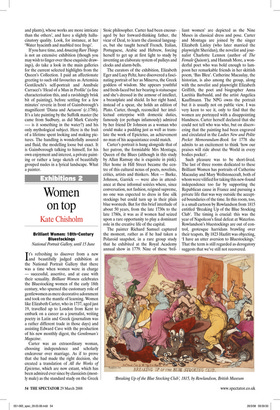Women on top
Kate Chisholm
Brilliant Women: 18th-Century Bluestockings National Portrait Gallery, until 15 June It’s refreshing to discover from a new and beautifully judged exhibition at the National Portrait Gallery that there was a time when women were in charge — successful, assertive, and at ease with their sexuality. Brilliant Women celebrates the Bluestocking women of the early 18th century, who spurned the customary role of gentlewomen as mere decorative adornment and took on the mantle of learning. Women like Elizabeth Carter, who in 1737, aged just 19, travelled up to London from Kent to embark on a career as a journalist, writing poetry in Latin and Greek (journalism was a rather different trade in those days) and assisting Edward Cave with the production of his new monthly digest, the Gentleman’s Magazine.
Carter was an extraordinary woman, choosing independence and scholarly endeavour over marriage. As if to prove that she had made the right decision, she created a translation of All the Works of Epictetus, which are now extant, which has been admired ever since by classicists (mostly male) as the standard study on the Greek Stoic philosopher. Carter had been encouraged by her forward-thinking father, the vicar of Deal, to learn the classical languages, but she taught herself French, Italian, Portuguese, Arabic and Hebrew, forcing herself to get up at first light to study by inventing an elaborate system of pulleys and clocks and alarm-bells.
The curators of the exhibition, Elizabeth Eger and Lucy Peltz, have discovered a fascinating portrait of her as Minerva, the Greek goddess of wisdom. She appears youthful and fresh-faced but her bearing is statuesque and she’s dressed in the armour of intellect, a breastplate and shield. In her right hand, instead of a spear, she holds an edition of Plato. Carter, though, reconciled her intellectual enterprise with domestic duties, famously (or perhaps infamously) admired by her friend Dr Johnson as a woman who could make a pudding just as well as translate the work of Epictetus, an achievement no man of his acquaintance could match.
Carter’s portrait is hung alongside that of her patron, the formidable Mrs Montagu, Queen of the Blues (although in this study by Allan Ramsay she is exquisite in pink). Her home in Hill Street became the centre of this cultural nexus of poets, novelists, critics, artists and thinkers. Men — Burke, Johnson, Garrick — were also in attendance at these informal soirées where, since conversation, not fashion, reigned supreme, no one was expected to dress in fine silk stockings but could turn up in their plain blue worsteds. But for this brief interlude of about 50 years, from the late 1730s to the late 1780s, it was as if women had seized upon a rare opportunity to play a dominant role in the creative life of the capital.
The painter Richard Samuel captured the moment, rather as if he had taken a Polaroid snapshot, in a rare group study that he exhibited at the Royal Academy annual show in 1779. Nine of these ‘bril liant women’ are depicted as the Nine Muses in classical dress and pose. Carter and Montagu are joined by the singer Elizabeth Linley (who later married the playwright Sheridan), the novelist and journalist Charlotte Lennox (author of The Female Quixote), and Hannah More, a wonderful poet who was bold enough to lampoon her remarkable friends in her skittish poem, ‘Bas Bleu’. Catherine Macaulay, the historian, is also among the group, along with the novelist and playwright Elizabeth Griffith, the poet and biographer Anna Laetitia Barbauld, and the artist Angelica Kauffmann. The NPG owns the portrait but it is usually not on public view. I was very keen to see it, only to find that the women are portrayed with a disappointing blandness. Carter herself declared that she could not tell who was who, but on discovering that the painting had been engraved and circulated in the Ladies New and Polite Pocket Memorandum-Book for 1778 she admits to an excitement to think ‘how our praises will ride about the World in every bodies pocket’.
Such pleasure was to be short-lived. The last of three rooms dedicated to these Brilliant Women has portraits of Catherine Macaulay and Mary Wollstonecraft, both of whom were vilified for taking this new-found independence too far by supporting the Republican cause in France and pursuing a private life that was way outside the accepted boundaries of the time. In this room, too, is a small cartoon by Rowlandson from 1815 entitled ‘Breaking Up of the Blue Stocking Club’. The timing is crucial: this was the year of Napoleon’s final defeat at Waterloo. Rowlandson’s bluestockings are out of control, grotesque harridans brawling over their teapots. By 1823 Hazlitt was objecting, ‘I have an utter aversion to Bluestockings.’ That the term is still regarded as derogatory suggests that we’ve still not recovered.
















































































 Previous page
Previous page